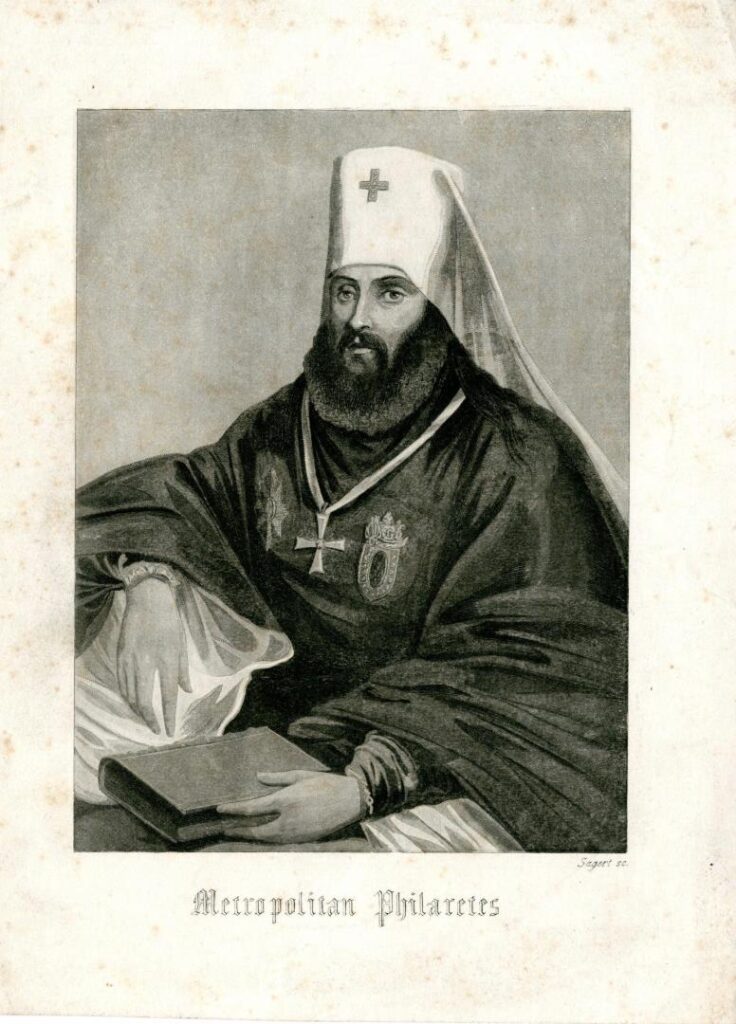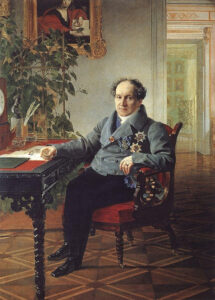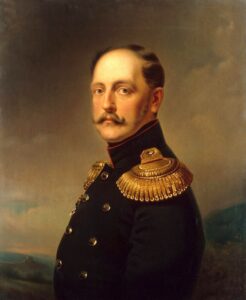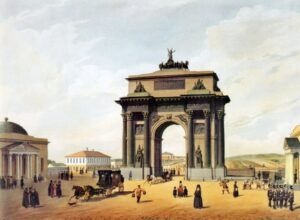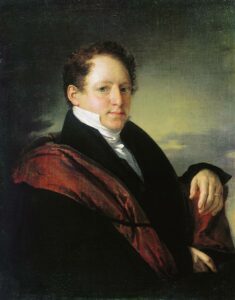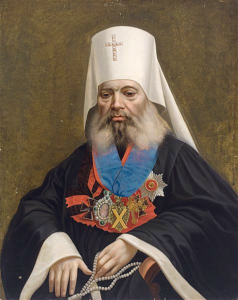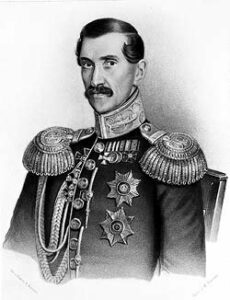Some people think of nineteenth century Russia as an idealized Orthodox society – Holy Russia, a civilization on par with the golden age of the Byzantine Empire as a bastion of Orthodoxy. The reality of both societies is much more complicated.
The nineteenth century as “Holy Russia” is not a fiction. The Russian Church of this era had an abundance of God-bearing elders and wonderworkers – Seraphim of Sarov, the Optina elders, John of Kronstadt, and so many more. It had great missionaries like Herman and Innocent of Alaska and Nikolai of Japan. It had wise hierarchs like Philaret of Moscow, and theologians like Theophan the Recluse and Ignatius Brianchianinov. There’s a reason that nineteenth century Russia is viewed by many as holy, and this is why.
But there’s another side of the story – a more complicated side. That’s what we will focus on today: specifically, on the period from the early 1820s (that is, the last years of Tsar Alexander I) through the mid-1850s (the death of Tsar Nicholas I).
The Reign of Tsar Alexander I
In 1824, a series of controversies came to a head involving the Russian Bible Society, which was led by Prince Alexander Golitsyn, Ober Procurator of the Holy Synod. (The Ober Procurator was the Tsar’s official representative on the Holy Synod, and without him, the Holy Synod was not allowed to function.) The Bible Society had already been tarred with associations with Freemasonry, thanks to so many of its leaders being Freemasons. Not a specifically Orthodox endeavor, the Bible Society’s leadership included not only Orthodox churchmen like Golitsyn and St Philaret of Moscow, but also Protestants and Roman Catholics, including the popular St Petersburg Roman Catholic priest Johannes Gossner, who came to Russia from Bavaria and converted hundreds of Russians to Roman Catholicism. Gossner and a fellow Roman Catholic priest were viewed with deep suspicion by the Orthodox, not only because of their heretical religion but also because of their private lives – both men lived openly with young women whom they claimed to be their nieces. Gossner was eventually expelled from St Petersburg, but not before publishing a problematic biblical commentary. In what some viewed as divine retribution, the Russian translator suddenly fell over dead while praying at Gossner’s home in early 1824. All of this served to further undermine trust in the Russian Bible Society.
Soon, two of the three most powerful bishops in the Russian Church – Metropolitans Seraphim of St Petersburg and Evgenii of Kiev – took direct aim at the Bible Society, attacking it in a formal letter. The two metropolitans argued that the Bible Society’s mixture of Orthodox and heterodox was uncanonical, that the translations were problematic, and that the sale of Bibles was unethical. The metropolitans said that the Bible Society should be shut down, and they were supported in their arguments by Archimandrite Photius Spassky, the personal confessor to the Tsar. Spassky privately lobbied the Tsar to remove Alexander Golitsyn as Ober Procurator, and the famed poet Alexander Pushkin published a mocking verse about the Ober Procurator:
Here we have the soul of a slave,
Education’s chief destructor…
For God’s sake put pressure on him,
From all sides attack withal!
From behind shall we not try him?
That’s his weakest side of all.
Finally, in May, Tsar Alexander removed Golitsyn from his post, ending an era in Russian Church history. With Golitsyn’s ouster, ironically, Metropolitan Seraphim of St Petersburg was appointed by the Tsar to lead the Russian Bible Society – a body which Seraphim himself advocated disbanding. The Society lingered on for a little while longer until its formal closure by Tsar Nicholas I in 1826.
In a related development, the Russian Church commission in charge of seminary education, which had finally authorized the use of Russian (rather than the dominant Latin) for classroom instruction, reversed course: Russian was now banned because it was the vernacular, and the vernacular was equated with Protestant tendencies. Latin was again mandated as the only acceptable language for seminary instruction, despite its obvious association with Roman Catholicism and its general impracticability in a Russian seminary context.
On November 7, the city of St Petersburg, Russia was devastated by a flood of historic proportions, with the water reaching a height of 4.2 meters (nearly 14 feet) above sea level. Several hundred people died, cesspools and gutters flooded into the streets, and the city’s sanitary conditions went from bad to worse. It took more than a decade for St Petersburg to recover, with the long delay creating conditions for a cholera outbreak in 1831. According to legend, when an old main claimed that the flood was God’s punishment for our sins, Tsar Alexander I replied, “No, not for our sins, but for mine!”
In 1825, the entire Russian Empire included just 11,080 monastics (of whom just over half were tonsured monks and nuns, with the rest novices). The empire had 476 monasteries.
In November 1825, in the remote town of Taganrog, Tsar Alexander I was beset by a strange illness that (apparently) took his life on November 19 / December 1. For the better part of a month, the succession of the Russian throne was unclear: Alexander had no legitimate living children, and his presumptive heir, his next-younger brother Constantine, refused the crown. Next in line was the third brother, Nicholas, who himself pledged allegiance to Constantine – as did everyone else.
What few at the time knew was that Alexander had executed a secret will in 1823 – written, in fact, by St Philaret of Moscow. The will passed over Constantine in favor of Nicholas. But it wasn’t public, and Nicholas waited to see what his elder brother Constantine would do. Finally, Constantine formally renounced his claim to the throne, and Nicholas became Tsar on December 13/25. The following day, in St Petersburg, a group of officers and several thousand soldiers revolted against Nicholas’s rule. The rebellion was quickly put down, and has been remembered as the “Decembrist revolt.” A few days later, St Philaret of Moscow addressed the crowds. As the author of Tsar Alexander’s secret will, he made its contents public for the first time, calling on everyone to swear allegiance to Nicholas. Making the sign of the cross over the people, he declared them to be absolved of their previous oath of allegiance to Constantine, saying, “I absolve you and bless you!”
Within a short period of time, rumors began to spread that Tsar Alexander had not actually died – it was whispered that he had faked his own death and that another man’s body rested in his casket.
The Reign of Tsar Nicholas I
In April 1826, Tsar Nicholas issued a decree formally shutting down the Russian Bible Society and mandating that, going forward, the publication of the Scriptures in Russia must be in Church Slavonic, not modern Russian – although the Tsar did allow the continued circulation of Russian Bibles already in existence.
On August 22/September 3, Nicholas I was formally crowned Tsar of Russia in St Petersburg. In his homily, St Philaret of Moscow compared Nicholas’s coronation to that of the Biblical King Solomon, bringing the newly-crowned Tsar to tears. In gratitude for his invaluable support, the Tsar raised Philaret from Archbishop to Metropolitan.
In June, one of Tsar Nicholas’s advisors had briefed him on the problem of clergy misbehavior. In response, Nicholas issued an order to the Holy Synod, instructing them to consider ways to address the problem – specifically, how to improve the training and preparation of prospective clergymen. Notably, Nicholas suggested that all seminary graduates be ordained without their consent – apparently a way to increase the pool of clergymen in the church. By November, Synod members and other churchmen submitted their responses to the Tsar, and in December, the Synod met and concluded that the problem facing the Russian Church was not a need for more clergy in general, but to attract new clergymen to poor, rural parishes. For this, some kind of special assistance would be needed, including good land and financial support. Discussions and deliberations about church reform continued well into 1827.
During the same period, in November, Alexander Mansurov, a high-ranking Tsarist military officer and diplomat, received permission from Tsar Nicholas to marry his own second cousin. The wedding took place on November 12/24, and when St Philaret of Moscow learned of it two days later, he protested that the marriage was illegitimate – under the canons of the Church, marriage between second cousins is incestuous. The Tsar provided cover for the couple and then assigned Mansurov to a diplomatic post outside the country. Very soon after this, Mansurov’s cousin-wife died – a tragedy that might reasonably be interpreted as divine judgment. For his part, St Philaret offered his resignation as Metropolitan of Moscow, although this never took effect.
In February 1827, word reached Tsar Nicholas about a priest in Kursk who was involved in an illicit relationship with a peasant woman. The Tsar ordered the priest to be defrocked, and he rebuked the local bishop. This was one of a long string of incidents in which the Tsar became increasingly disgusted with the state of discipline in the Russian Church – a disgust that might be seen as hypocritical given his own blatant disregard for church discipline in the Mansurov affair just weeks earlier. The next year, Nicholas heard that an intoxicated priest had dropped the Holy Gifts. Soon after this, the Tsar ordered a purge of all clergy with tainted records. Nicholas came to understand that laxity among the bishops was the real problem, as hierarchs generally failed to correct misbehavior among their clergy. At around this time an anonymous memorandum was delivered to the Tsar, challenging the Holy Synod’s competence to lead the Church. The memorandum called for the creation of a “provisional ecclesiastical council” to assist the Synod. While St Philaret of Moscow recognized the serious problems that existed in the Russian Church, he convinced the Tsar not to consider any changes to church structure.
In April 1828, after almost two years of deliberation and information gathering about church reform, the Holy Synod of Russia presented a reform proposal to Tsar Nicholas. The proposal was largely influenced by St Philaret of Moscow, and, among other things, called for only seminary graduates to be ordained priests (and preferably not before the canonical age of thirty), construction of parish rectories for clergy families, and four-year terms with state-funded stipends and land allotments for rural priests. The government countered, proposing that the parishes themselves, not the state, should bear the financial burden of funding their clergy. The two sides – the Synod and the government – went back and forth with their proposals for the rest of the year.
The parish reform project finally concluded in 1829, when Nicholas signed the reforms into law. The final product was a disappointment to the Synod’s dominant voice, St Philaret, as the government had watered down many of the Synod’s proposed reforms, particularly the proposal to mandate the construction of parish rectories and the allotment of land for rural priests. Even so, the project did succeed in several respects, including securing financial aid for rural clergy and requiring seminary education for priests. The reforms also called for many poor parishes to be closed and merged into neighboring parishes.
Now that the reform project was signed into law, the Synod was faced with the difficult task of implementation. This turned into a years-long headache: the Synod had to survey every diocese in the Russian Church to identify what parishes qualified as “poor” and thus eligible for financial aid. Diocesan reports were notoriously incomplete and unreliable, leading to long delays in funding. This irritated the Tsar and frustrated church leaders; St Philaret of Moscow even censured his own diocesan administration for their unacceptable parish reports. The reform project also faced popular opposition, as many people did not want their home parish to be closed simply because it was classified as “poor.”
As this was happening, the Tsarist government had commissioned a triumphal arch in Moscow to commemorate the Russian victory over Napoleon, and St Philaret was asked to bless the new monument at a public ceremony in August. To the government’s surprise, Philaret refused: the arch depicted the pagan goddess Nike, and St Philaret declared that it was impossible to bestow a blessing on such an object.
A global cholera pandemic, which had begun in India in 1817, reached Moscow in September 1830. It went on to kill a quarter-million people in Russia and led to a series of “cholera riots” against the government’s anti-cholera measures. St Philaret of Moscow gave a series of sermons on the outbreak, comparing it to the plague that struck Israel at the time of King David as a punishment for his sin. Some misinterpreted St Philaret as putting the blame for the disease on Tsar Nicholas, and the embarrassed Philaret apologized in a subsequent sermon in October, clarifying that the Tsar had done nothing wrong, but rather that the sins of the whole nation were to blame.
In June 1831, the cholera pandemic reached a crisis level in St Petersburg. In a two-week period, 600 people died, including nobles close to Tsar Nicholas. A conspiracy theory emerged that the disease was part of a government plot to kill off the population, and on June 22, a crowd of peasants rioted, attacking a cholera hospital, dragging patients from their beds and murdering doctors. The local police were completely overmatched, and the riot ended only when the Tsar himself appeared in the market square and rebuked the crowd. The people, angry at the government but loyal to their emperor, knelt before him and cried out, “We have sinned! We are accursed!” Tsar Nicholas then commissioned St Philaret to ghostwrite a manifesto to the Russian nation, which was published under the Tsar’s name in August.
***
In April 1833 (for context, this was three months after the death of St Seraphim of Sarov), Tsar Nicholas I transferred the “upright, pious, and rather passive” Holy Synod Ober Procurator Mescherskii to the senate. In his place, Nicholas appointed Stepan Nechaev as the new Ober Procurator. Nechaev, a power-hungry Freemason, did all that he could to weaken the authority of the bishops, surrounding them with spies and meddling in church affairs. He clashed repeatedly with St Philaret of Moscow.
After three difficult years under Nechaev, St Philaret and the entire Holy Synod succeeded in convincing Tsar Nicholas to remove the Ober Procurator in 1836. Historian David Edwards writes of Nechaev, “After three years of intense work, he succeeded in changing the spirit of the Holy Synod and increasing the scope of the overprocurator’s duties. However, his brief time in office must be seen as a prelude to the powerful rule of Count N.A. Protasov.”
Unlike Nechaev, the new Ober Procurator Protasov was actually a practicing Orthodox Christian with a chapel in his home. One metropolitan described him as a man “well known for his intellect, education, and zeal for the Orthodox church.” Soon enough, though, the bishops found Protasov to be just as domineering as his predecessor. After his appointment, Protasov himself wrote, “Now I am the commander-in-chief, the patriarch, the Devil alone knows what I am.” Under the new Ober Procurator, the Church was ever more subjected to the state. Diocesan borders were adjusted to match the borders of civil provinces. Clergy were treated in the same manner as civil servants, with the last vestiges of the old method of clergy elections abolished. Bishops were not elected by the Holy Synod but merely nominated, with their final appointment coming from the Tsar. All of this led the historian Dimitry Pospielovsky to write, “The process of converting the Church into a state bureaucracy totally subordinate to the government, which had begun under Peter the Great, was completed under Nicholas I.”
In June 1838, the Holy Synod called for changes to seminary education to root out tendencies toward scholasticism in favor of a more pastoral approach to theology. The Synod decreed, “The teaching of all aspects of theology should be adapted for [real] application; as far as possible, it should be free from the arid, unintelligible forms of scholasticism; and it should not be governed by a striving for brilliant, but unfeeling, erudition.” Following this, the church commission overseeing theological education directed seminaries to use St Peter Mohila’s Confession as the foundation of its curriculum, rather than scholastic textbooks. The curriculum was also modified, adding courses on patristics and early church history along with expanded study of the Scriptures.
Back in 1824, the Russian Church commission in charge of seminary education had banned the use of the Russian language in classroom instruction and mandated that only Latin was acceptable. This was done because the vernacular was associated with Protestant tendencies. But by the end of the 1830s, it was clear that Latin simply could not continue to be used – students did not understand it – and Russian was emerging as the dominant language in seminaries. Some bishops thought that this was a negative development. Metropolitan Philaret of Kiev argued that Latin was necessary to study the Church Fathers. His Moscow counterpart, St Philaret, countered that if we want to teach students theology, we must do so in a language they can actually understand. St Philaret added, “Besides, the fact that Orthodox theology is dominated by Latin, once pagan but now papist and protestant, is not a phenomenon fully consistent with the spirit and goal of ecclesiastical schools of the Eastern Church.”
***
A decade after the Russian Church began its parish reform project of 1829, the topic of reform remained a hot one. The first reform attempt had been largely a failure – the necessary diocesan reports were incomplete and unreliable, and ordinary parishioners rejected the plan to close poorer parishes. One of Tsar Nicholas’s advisors proposed a new round of reforms, and in January 1839 the Tsar established a committee to evaluate parish life. Significantly, this committee did not include any members of the Holy Synod, and was instead led by an auxiliary bishop and composed mostly of lay officials. The Tsar instructed the committee to focus especially on how to help parishes in the western provinces of the Empire, where a movement was gaining momentum among Greek Catholics (Uniates) in Lithuania and Belarus to rejoin the Orthodox Church. Meeting over the next three months, the committee ultimately recommended that the Russian state provide each parish in the western provinces with large cash subsidies, and it also recommended that parishes be required to build a rectory and provide and cultivate land for the priest. The committee proposed that the traditional gifts to clergy at baptisms, weddings, and funerals – which provided the bulk of clergy compensation – be abolished and replaced by a regular salary. The proposal was sent to the Tsar; however, no action was taken immediately, and subsequent crop failures led the government to delay implementation of the reforms.
Back when St Philaret of Moscow was rector of the St Petersburg Theological Academy, his best student was the future priest Gerasim Pavskii, who went on to become a noted theology professor and tutor and confessor to the imperial heir-apparent, Tsarevich Alexander (the future Alexander II). Although translations of the Bible into modern Russian had been banned since 1826, while he was teaching at the St Petersburg Theological Academy, Pavskii produced private Old Testament translations – crucially, using the Hebrew Masoretic rather than the Greek – and over the years copies of these translations (along with Pavskii’s chapter headings and notes) circulated amongst students at the three great Russian theological academies of St Petersburg, Moscow, and Kiev. In January 1842, word of this finally reached the Holy Synod, which opened an investigation. Individual theology students were called in for rigorous questioning. Pavskii himself was interrogated repeatedly, including many times by St Philaret, who concluded in a report in May that, while Pavskii was innocent of any role in distributing copies of his translations, his editorial commentary – chapter headings, notes, etc. – were not sufficiently Orthodox. The illicit copies of Pavskii’s translations were collected and burned.
The most significant fallout from the Pavskii affair was the forced resignation from the Holy Synod of two of the three leading hierarchs in Russia – Philaret of Moscow and Philaret of Kiev, who were forced out of the Synod by the all-powerful Ober Procurator, Count Protasov. Historian David Edwards writes, “With the departure of these two clerics, Overprocurator Protasov ruled over a docile Synod and truly became ‘a Patriarch in a soldier’s uniform.’” Edwards goes on to describe the bleak state of church leadership in this period:
The overprocurators arbitrarily violated protocol, unilaterally changed the decrees and resolutions of the Synod, and frequently prevented the recording of the Synod members’ opinions during meetings. Furthermore, once the synodal bureaucracy was in place, Protasov funneled all ecclesiastical business through lay appointees. All questions of policy, from both clerics and laymen, passed through these bureaucrats, who decided what the Synod would discuss. Finally, the hierarchs in the Synod in effect lost the privilege to appoint clerics to vacant episcopal sees. Before the advent of Nechaev, the Synod would choose three candidates for a vacancy but indicate its first choice. The overprocurator would then forward this recommendation to the tsar, who would follow the Synod’s advice. Under both Nechaev and, in particular, Protasov, the procedure was fundamentally changed; now the overprocurator, not the Synod, recommended the men for vacancies.
Protasov was in complete control, with the Tsar following his recommendations with few exceptions. Any bishop who objected to Protasov’s actions was subject to discipline. Although supposedly a practicing Orthodox Christian, Protasov treated the hierarchs with contempt, sometimes calling them “batiushka,” a term used to refer to parish priests. At other times, Protasov would scream at the bishops. As one account puts it, “Protasov took them in hand as though in the military and at once drilled the crowd of archbishops like a squadron.”
While all this was happening, Protasov also pushed hard for the completion of the “western provinces” parish reform project that had begun in 1839. The reforms were finalized and duly approved by the Tsar, and were applied to five dioceses in the western part of the Empire. A salary scale was imposed, supported in part by state subsidies, and parishioners were obligated to provide their parish priest with housing, land, and free labor, among other things. While clergy were barred from asking for payment in exchange for baptisms, weddings, and funerals, parishioners were free to make voluntary gifts if they chose. As with the previous attempt at parish reform thirteen years earlier, in the end, implementation was a huge problem, and in many cases the reforms never took effect. The difference between this 1842 reform and the earlier 1829 is that the earlier set of reforms came from the Holy Synod, while these new reforms were a product of a government committee dominated by laymen.
***
As the first half of the nineteenth century came to a close, the cholera problem worsened. In the Russian Empire, over one million people died of the disease between 1847 and 1851 – about 1.5 percent of the country’s population. Then, in 1853, Russia declared war on the Ottoman Empire, beginning the devastating Crimean War, which would transform global Orthodoxy in a variety of ways. The rather dark Tsar Nicholas/Count Protasov era of Russian Orthodoxy came to an end in 1855, when both men died within about a month of each other, and soon afterward, the Crimean War came to a close. St Philaret returned to the forefront of the Russian Church, although he never formally rejoined the Holy Synod.
I just called this a “dark era,” and it was. But, as I noted at the beginning of this article, it was also an era of remarkable holiness. Optina Monastery emerged as a great center of pilgrimage, home to a line of God-bearing elders. These startsy, along with spiritual giants such as St Seraphim of Sarov, served as heirs and transmitters of the hesychast teachings of St Paisius Velichkovsky, sparking a rebirth of spirituality in the Russian Orthodox Church. Meanwhile, great missionaries traveled from Russia to the far reaches of the Empire and beyond. The era described in this article spans the early years of such men as Fyodor Dostoyevsky (born 1821), St John of Kronstadt (1829), and St Nicholas of Japan (1836).
It was also the era that gave birth to St Ilia Chavchavadze, the great leader of the Georgian people, who suffered during this period from suppression by the Russian state and church.
History is complex, but this is only because reality is complex. The past is no more or less straightforward than the present. I have told this story not to bring shame upon anyone, or to cause scandal, but to present the truth of the past in all of its messiness, with beauty and ugliness, sanctity and sin, coexisting in the same space. This, I’m afraid, is part and parcel of being Israel – the people of God – in a fallen world.
Main Sources
There are loads of good sources on Russian Orthodoxy in this period. Here are the ones I relied on the most for this article.
Stephen K. Batalden, Russian Bible Wars: Modern Scriptural Translation and Cultural Authority (Cambridge University Press, 2013).
David W. Edwards, “The System of Nicholas I in Church-State Relations” in Robert L. Nichols and Theofanis George Stavrou, eds., Russian Orthodoxy under the Old Regime (University of Minneapolis Press, 1978), 154-169.
Gregory L. Freeze, The Parish Clergy in Nineteenth-Century Russia: Crisis, Reform, Counter-Reform (Princeton University Press, 1983).
Dimitry V. Pospielovsky, The Orthodox Church in the History of Russia (St Vladimir’s Seminary Press, 1998).
Nicholas S. Racheotes, The Life and Thought of Filaret Drozdov, 1782-1867: The Thorny Path to Sainthood (Lexington Books, 2019).
Michelle R. Viise, “Filaret Drozdov and the Language of Official Proclamations in Nineteenth-Century Russia,” The Slavic and East European Journal 44:4 (Winter 2000), 553-582.
